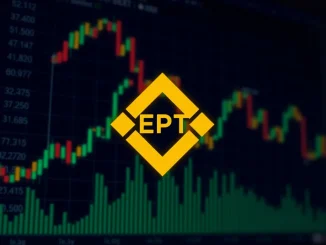
Are you trying to gauge the pulse of the Bitcoin market? One of the key indicators savvy traders watch is the BTC long-short ratio. This metric offers a glimpse into the overall market sentiment by showing the proportion of traders betting on Bitcoin’s price going up (long positions) versus those expecting it to fall (short positions. Let’s dive into the latest 24-hour snapshot of Bitcoin perpetual futures across leading crypto exchanges and see what it reveals about current market sentiment.
Decoding the 24-Hour BTC Long-Short Ratio: A Sentiment Snapshot
For the past 24 hours, the aggregate BTC long-short ratio across all tracked exchanges stands at:
Total Exchanges: Long 50.1%; Short 49.9%
At first glance, this near-even split might seem insignificant. However, even slight imbalances can offer valuable clues about the prevailing trader mindset. A ratio tilted slightly towards long positions, as we see here, can suggest a cautiously optimistic outlook, while a heavily skewed ratio in either direction could indicate stronger bullish or bearish conviction.
Examining Top Crypto Exchanges: Binance, OKX, and Bybit
To get a more granular view, let’s break down the Bitcoin perpetual futures long-short ratios on three of the most prominent crypto exchanges:
- Binance: Long 49.78%; Short 50.22%
- OKX: Long 50.96%; Short 49.04%
- Bybit: Long 51.05%; Short 48.95%
Interestingly, we observe subtle variations across these platforms. Binance shows a slight lean towards short positions, while OKX and Bybit indicate a marginally stronger inclination towards long positions. These nuances can sometimes reflect the specific user base and trading dynamics unique to each exchange.
Why Track the Bitcoin Long-Short Ratio?
Understanding the BTC long-short ratio can be incredibly beneficial for traders and investors. But why is this data point so important?
- Gauge Market Sentiment: As mentioned, the ratio provides a real-time snapshot of whether the majority of leveraged traders are leaning bullish or bearish on Bitcoin. This can be a valuable contrarian indicator. For example, an excessively high long ratio might suggest an overleveraged market ripe for a potential correction.
- Identify Potential Liquidation Levels: Extreme long or short positions can hint at potential liquidation cascades. If a large number of traders are heavily long, a sudden price drop could trigger mass liquidations, exacerbating the downward pressure. Conversely, heavy shorts could fuel a short squeeze if the price starts to rise.
- Inform Trading Strategies: Some traders incorporate long-short ratio data into their trading strategies. For instance, a contrarian trader might look to fade the prevailing sentiment, taking short positions when the long ratio is very high and vice versa.
- Assess Exchange-Specific Dynamics: Monitoring ratios across different crypto exchanges can reveal platform-specific trends and potential arbitrage opportunities. Significant divergences in ratios between exchanges might warrant further investigation.
How to Interpret These Ratios for Actionable Insights?
While the BTC long-short ratio is a useful tool, it’s crucial to understand how to interpret it effectively. Here are some key considerations:
- Context is King: Don’t look at the ratio in isolation. Consider it alongside other indicators like price action, trading volume, open interest, and broader market news. A slightly long ratio in a strong uptrend might be less concerning than the same ratio during a period of market uncertainty.
- Watch for Extremes: Pay close attention to significant deviations from the 50/50 balance. Ratios that are heavily skewed (e.g., 70% long or 70% short) are often more meaningful than minor fluctuations.
- Trend Analysis: Observe the trend of the long-short ratio over time. Is it consistently increasing, decreasing, or fluctuating? A sustained trend can be more informative than a single data point.
- Combine with Technical Analysis: Use the ratio in conjunction with technical analysis techniques. For example, if the ratio is showing increasing long positions as Bitcoin approaches a key resistance level, it might signal potential exhaustion and a possible pullback.
Limitations to Consider
It’s important to acknowledge that the BTC long-short ratio is not a foolproof predictor of market movements. Here are some limitations:
- Exchange Coverage: The data typically only covers major centralized exchanges. It doesn’t capture sentiment on decentralized exchanges (DEXs) or in the over-the-counter (OTC) markets.
- Data Aggregation: Different data providers may aggregate and calculate ratios slightly differently, leading to minor discrepancies.
- Lagging Indicator: The ratio reflects past and present positioning, not necessarily future price action. Market sentiment can shift rapidly.
- Manipulation Potential: In theory, large players could attempt to manipulate ratios, although this is generally difficult to do across multiple exchanges.
Conclusion: Navigating Bitcoin Market Sentiment with Long-Short Ratios
The 24-hour BTC long-short ratio offers a valuable, albeit nuanced, glimpse into the prevailing market sentiment surrounding Bitcoin futures. While the current data suggests a marginally long-biased market across major crypto exchanges like Binance, OKX, and Bybit, the near-even split underscores a degree of uncertainty. By monitoring these ratios in conjunction with other market indicators and understanding their limitations, traders can gain a more comprehensive perspective and make more informed decisions in the volatile world of cryptocurrency trading. Stay informed, stay vigilant, and use every tool at your disposal to navigate the exciting, yet complex, Bitcoin market.



